New CCT Postcards, Hot Off the Presses!
Hey everyone, here’s the latest from the Canadian Culture Thing postcard line…









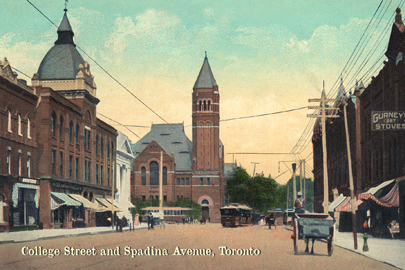
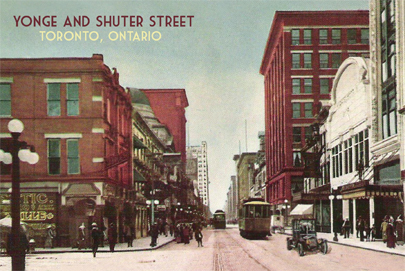



Hey everyone, here’s the latest from the Canadian Culture Thing postcard line…














146 years ago, after some really crazy make-up sex, the French and English gave birth to a nation of the future.
Canada, you really are aging well. You don’t look a day over 126.

Some History
The Iran Hostage Crisis began on November 4, 1979 (known in Iran as the Conquest of the American Spy Den). It was the result of a breakdown in diplomatic relations between Iran and the United States when a group of Islamic students and militants stormed the American embassy in Tehran and held 52 Americans hostage for 444 days. Described as an entanglement of “Vengeance and mutual incomprehension”, Iran saw the action as an acceptable response to the undermining influence the United States had been having on the Iranian Revolution. This American support of the recently overthrown Shah of Iran, Mohammad Reza Pahlavi drew much ire from the revolutionaries. The Shah had been restored to power in a 1953 coup d’état organized by the C.I.A. at the American Embassy against a democratically elected nationalist Iranian government, led by the anti-Soviet and anti-British Prime Minister Mohammad Mosaddegh. While the even most likely kept President Jimmy Carter from a second term, In Iran, the crisis strengthened the prestige of the Ayatollah Khomeini and the political power of those who supported theocracy. The U.S. Iran relationship would never recover.
The Muslim Student Followers of the Imam’s Line, the group responsible for the occupation of the embassy, had never intended to remain in the embassy for “more than a few hours” in order to announce their objections, and “to detain the diplomats for a few days, maybe a week, but no more” but with the growing support of hundreds of protestors outside the embassy showing their support for student’s occupation which made it impossible end their campaign.
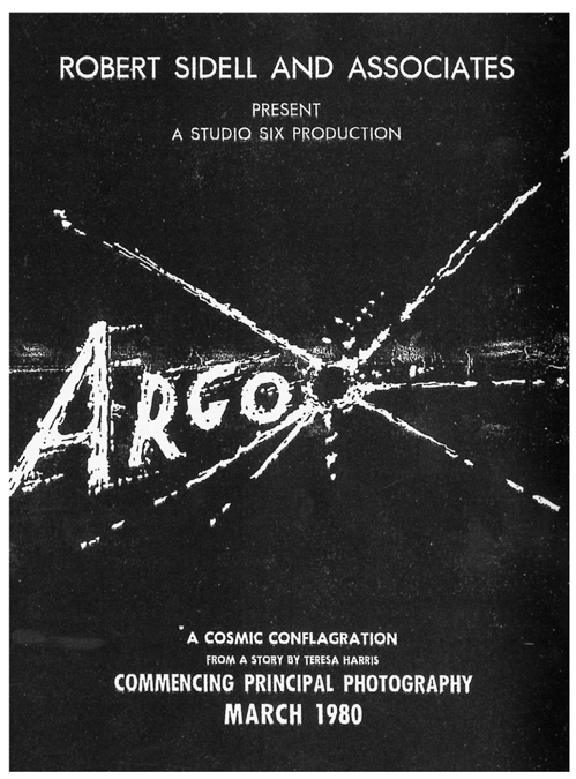
While this primetime drama was unfolding (this is the Canadian Culture Thing, not the American or Iranian Culture Things) six American diplomats had evaded capture and escaped to the British embassy and then to the Canadian. From there they were hidden at the home of Canadian diplomat (and hero) John Sheardown under the protection of Canadian ambassador (and hero) Ken Taylor.
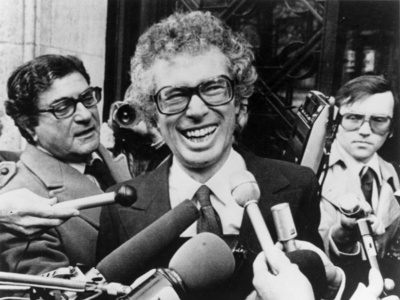
Knowing that the Iranians could be closing in on them at any time, Ken Taylor began organizing and implementing a plan to repatriate the six Americans. In late 1979, the Canadian Government secretly issued an Order of Council allowing the government to issue Canadian passports to selected American citizens so they could escape Iran. Under the veil of a Canadian crew shooting a science-fiction film called “Argo”, Canadian diplomats managed to get two CIA agents, Tony Mendez an agent known only as “Julio”, and six American diplomats on board a Swissair flight to Zurich, Switzerland. The January 28, 1980 escape of Robert Anders, Cora Amburn-Lijek, Mark Lijek, Joseph Stafford, Kathleen Stafford and Lee Schatz from Tehran, Iran became known as the Canadian Caper.
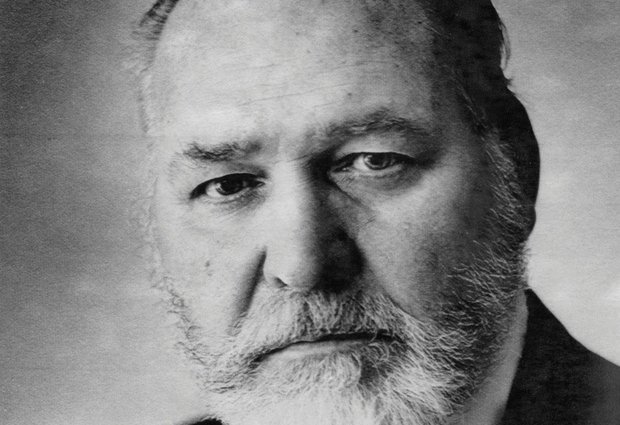
After several embarrassing failed U.S attempts to use force against Iran, the former Shah, a lynchpin in this event died. Immediately following the Shah’s death, Iraq invaded Iran and the pressure became too much and Iran began negotiations with the United States. After 444 days in captivity, the hostages were finally released into U.S. custody on January 20, 1981, a day after the signing of the formal release accord. This took place minutes after Jimmy Carter’s replacement: actor, politician, soldier, cowboy Ronald (Star Wars 1983 – not what you younger kids are thinking) Reagan was sworn into office. Referred to as “completely insane” by Prime-minister Pierre Trudeau, the people of Iran didn’t know how fortunate they were to have ended this international error-in-judgment when they did. Who can know what might have happened if the hostage release hadn’t been made and Bonzo’s Bedmate (1951) had a launch-key. Phew.
The account of the Americans absconding from Iran appeared as a Canadian-American co-production made-for-television movie cryptically called Escape from Iran: the Canadian Caper in 1981. But it wasn’t until master-thespian star of Daredevil and Gigli and now director/unhistorian Benjamin Geza Affleck decided to “make a movie” about the escape. Ben “Goebbels” Affleck believed that American audiences wouldn’t sit through a film where Canadians led and American followed. Instead of making Saving Private Ryan 2, this time it’s even less historical, he decided to mold history into a convenient bit of action-drama called Argo.
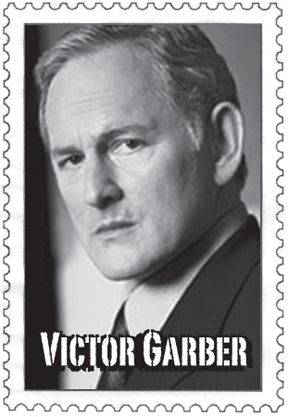
Argo is the fictional account of a team of American super-spies that save six hostages (and possibly the world) from the clutches of Iranian militants in Tehran. Directed by American actor (and side-show contortionist) Ben Affleck, Argo takes it’s viewers on a rollercoaster ride of excitement and intrigue while his Canadian viewers feel disappointment and anger as it boasts a make-believe tale of American ingenuity and heroism. When asked why he threw caution (and reality) into the wind, Affleck explained, “Canadians should rightly take pride in what they did for the six houseguests, the diplomats were heroic. That’s indisputable. But that part of the story had already been told. When you’re a filmmaker making a film based on a historical event, it’s your job to find a new way into a story.” Mr Affleck went on to say that “There would be a very compelling film that is primarily about the heroism of ambassador Taylor before Tony Mendez even hears about the crisis — and, in fact, that film already exists (1981’s ‘Escape From Iran: The Canadian Caper’ — starring Gordon Pinsent), we weren’t interested in remaking that film.”
The following is an excerpt from David Haglund’s Slate article on the inaccuracies of Argo:
Canada’s Involvement
The most disputed aspect of the movie’s version of events has to do with Canada’s role in the escape. 30 years ago, Canada received complete credit for the rescue, because the U.S. was worried about possible repercussions if CIA involvement was publicized. (They may also have wanted to maintain the plausibility of a similar ruse in future.) Argo corrects that version of events—or, rather, overcorrects it, downplaying the actual extent of Canadian involvement, which was considerable. The Americans were housed by two Canadians: the Ambassador Ken Taylor, and a Canadian embassy employee, John Sheardown. (In the film, all of them stay with Taylor; Sheardown does not appear at all.) It was Taylor who cabled Washington to begin the escape plan in earnest, and once the plan was decided on, Canadians “scouted the airport, sent people in and out of Iran to establish random patterns and get copies of entry and exit visas, bought three sets of airline tickets,” and “even coached the six in sounding Canadian.”
Almost none of that appears in Argo. Taylor himself has a major part, and is presented as a sympathetic and brave man who took great personal risks to save the Americans. But his actual role was even larger. He was “spying for the U.S. throughout the hostage crisis, at the request of Jimmy Carter.” After some friends who attended the Argo premiere in Toronto described it to Taylor, he expressed concern “that we’re portrayed as innkeepers who are waiting to be saved by the CIA,” which is a pretty fair description of what the film depicts. Affleck made a small change in response to this criticism: A postscript that contrasted Taylor’s 112 citations with the absence of credit given the CIA was rewritten to praise the Argo mission as a model of international cooperation.
Regarding the Escape
It’s not Canada’s involvement that has gotten the goat of some critics, though—it’s the pulse-pounding trip to the airport that serves as the movie’s climax. Affleck’s version involves every conceivable complication—each one of them, as it happens, invented purely to make the movie more exciting. (And it works! The finale is thrilling.) In the movie, the U.S. government reverses its approval of the plan at the last minute, meaning there may be no tickets waiting for the Americans when they arrive at the airport. In fact, the plane tickets were purchased ahead of time by the Canadians. Airport security guards stop the Americans in the film, leading to a tense and terrific scene in which one of the Americans makes the risky decision to speak Farsi with the guards, a daring move that pays off hugely. Actually, though, the trip through the airport was “smooth as silk,” as Mendez himself has written. Most improbably, the teams of carpet weavers that the Iranian government put to work repairing shredded documents (something they actually did!) piece together the face of one of the six Americans right as the group reaches the airport, and those carpet weavers relay the image to their higher-ups in time for armed men to chase down the departing airplane in a jeep and police cars. None of that happened. (David Haglund’s How accurate is Argo?)
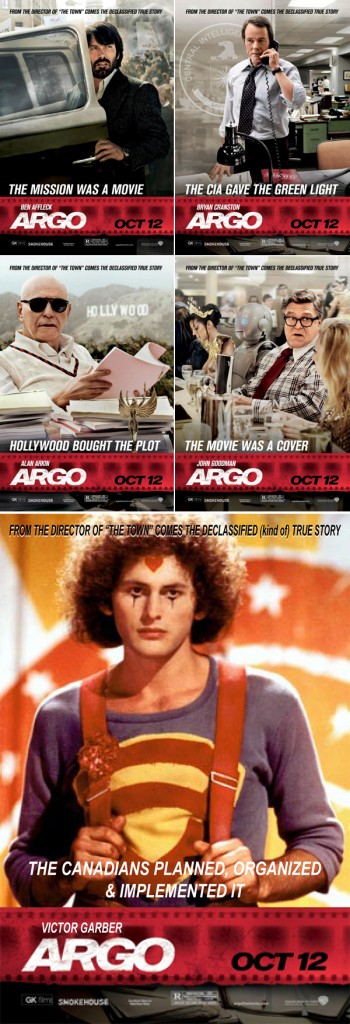
Future Affleck Projects
Now that Ben Affleck star of Laurence of Arabia (oh, that’s right he wasn’t even born yet when that film was made. I guess it doesn’t matter) decided to be a director, Canadian Culture Thing has put together a few ideas for some future projects…
Jaws: In the Affleck remake of the 1975 classic film, characters Quint, Hooper and Brody decide that Jaws is too scary to fight and so decide to stay on land. The day is saved when actor/director Ben Affleck playing new character Agent Chip Bigweiner flies in on his attack helicopter and diving into the water punches Jaws to death. In the final scene he shows off his pizza-slice sized shark tooth necklace and winks at the camera. Pure gold.
World War II: It’s 1939 and Germany has just entered Poland. The United States springs into action telling the allied nations to “take the day off. We got this one!” Germany is defeated in 1939by the American war-machine led by Buck Bigweiner (Chip’s grandfather)! Later in 1939, the Americans receive intelligence reports from code name Pinocchio, preemptively attacking Japan. Having anticipated that Japan had WEAPONS OF MASS AFFLECKTION and were about to launch an attack on the U.S. they move in to “sort ‘em out”. A struggle ensues aboard the Japanese Bomber the Enola Red Sun between Buck Bigweiner and twelve Samurai Warriors. In a reckless (and vague) happenstance, the Japanese drop an Atomic Bomb on their own people…twice! Wah-Hoo, git ‘er done!
Baseball Hot Shots: A patriotic baseball team of misfits and ne’er-do-wells led by Dirk Bigweiner, replaces the Atlanta Braves and defeats the Toronto Blue Jays in the 1992 World Series. This will be a great set-up for Baseball Hot Shots II where, replacing the Philidelphia Phillies, retired Dirk Bigweiner is convinced to come out of retirement to lead his ramshackle team of has-bins, hoodlums and a woman pitcher, on to defeat the Toronto Blue Jays again in World Series 1993!
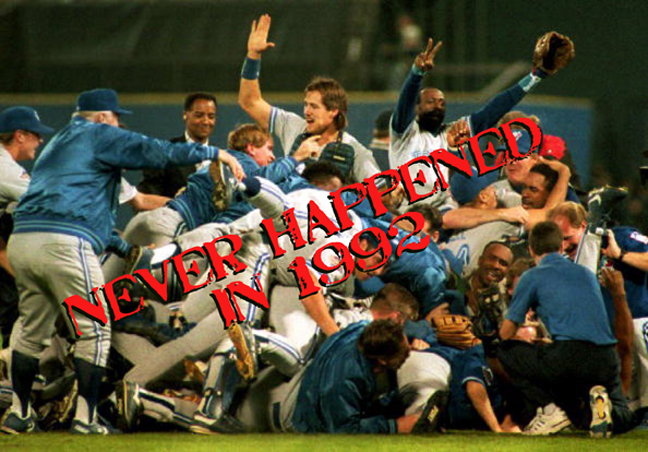
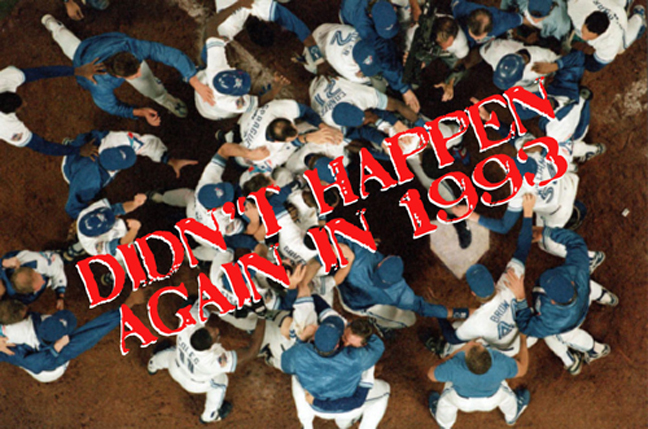
Argo Lord of Light: If he has a time machine as he might actual have (or at least he’ll just say that he does), he could go back in time and re-film Argo as the science-fiction film used in the cover-story. The (other) fictional film Argo is based of the novel Lord of Light by author Roger Zelazny with a screenplay by Barry Geller and concept art by comic-book giant Jack “King” Kirby. If Mr. Affleck, inventor of electricity, decides to pass on this adaptation he could always, in a Lucasian move, simply insert additional CGI into his existing Argo. Tony Mendez becomes the Buddha-esque Sam Bigweiner, struggling against the established gods in Iran with the assistance of the mythical Canadians.
I’m in for 5% Trustworthy Ben. Remember, I loved Dogma.
Argo won for Best Picture at the 85th Academy Awards in 2013. Argo beat out such docu-drams as Life of Pi and Les Misérables and children’s favourites like Lincoln and Django Unchained. While I’m not saying that Argo is a bad film, it’s just a little disappointing. I totally plan on seeing it when it plays on TV
The Death of the Penny
On February 4, the Royal Canadian Mint and financial institutions across Canada stopped distributing the Canadian one-cent piece. Production on the penny had ceased in May of 2012 looking forward to February 2013 when the penny would no longer be sent out to clink around in the pockets of Canadians. On that same day in February, the Canadian Mint began melting down the first of the 35 billion pennies in circulation.

One-Cent Worth of Patriotism
All Canadian coins minted between Confederation (1867) and 1935 have included the proud maple leaf but the penny has always shown it like no other. The first penny was produced on January 2, 1908 and was struck by Countess Grey at the official opening of the Ottawa branch of the Royal Mint (renamed in 1931 to the Royal Canadian Mint). The modern 1-cent coin that features two maple leaves on the same twig was designed and created by G.E. Kruger Gray. It was first used in 1937 and has remained unchanged until 2013 with the exception of the 1967 centennial coin, which used a rock dove, designed by renowned Canadian artist Alex Colville.
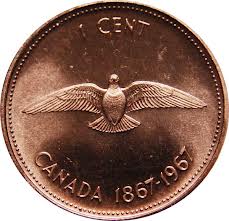
It Costs to Save Pennies
The beloved and seemingly pointless one-cent coin costs Canada 1.6 cents to produce and therefore the mint will melt down the 82-million kg of steel, nickel and copper-plating that remains in circulation and selling it.
Finance Minister Jim Flaherty is indeed correct to say that eliminating the penny will save Canadian tax-payers but his estimated 11 million dollars savings per year in production costs will actually result in a less impressive but still worthy $4 million savings. The cost to redeem the 6 billion coins will cost the Canadian government about $80 million over the next 6 years. The $80 million expense is a result of about $53 million to redeem the face-value of the 6 billion pennies jangling about in people’s pockets, and an impressive $27 million in administration, handling, and little signs that will be placed on fountains throughout Canada informing romantics that wishes now cost a nickel or higher.

Recycling the zinc and copper from melted-down pennies will bring in about $42.5 million in revenue. That, and the additional savings of $11 million per year, Canada will walk away with a savings of about $4 million per year over the 6 years it is expected to collect most of the circulating pennies.
A Pretty Penny
It will be great to save all that money in producing the penny but perhaps the Canadian government is missing an opportunity to make a little extra.
When King Edward VIII abdicated the throne in order to marry American divorcee Wallis Simpson, the Mint was just finishing up the tools to produce the new 1937 penny with the new king’s portrait. While the 1936 penny still had the image of King Henry V, the 1937 penny recycled the 1936 penny die along with a new portrait of the abdicating king’s on the reverse. To differentiate between the 1936 and 1937 pennies, the mint included a dot below the 1936 date to mark it as the 1937 penny.
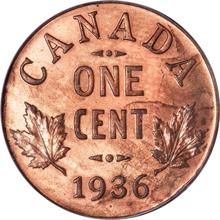
This of course makes this penny quite rare, there are only seven known rare dot coin specimens known to exist, as all other specimens are believed to have been melted by the mint. It might be worthwhile for the Mint to hire some students to pick through the pennies they collect and pull out any rare ones. I’m not a coin collector but being a comic book collector, it would horrify me to know that Marvel was collecting any comics they found and were recycling them. The idea that they would destroy an Avengers #4 amongst a heap of Alpha Flights sends me into a tizzy.

Now, that’s crazy-talk you might say but these precious 1937 pennies are worth a pretty penny (I couldn’t resist). These King Edward VIII pennies fetch as much as $402,500. In other words, ten of these little coins equals the $4 million dollars the Canadian government is going to save. Not to mention the other rare pennies they’ll come across. Now that’s worth enough to have a guy hand sort them.
Because the Royal Canadian Mint still doesn’t know what they’re going to do with any American pennies they collect, it might be possible to separate all those American pennies at the same time and let the U.S. redeem them from us. Ca-ching!
A Fishy Situation
While the beautiful koi swimming in Chinese restaurant ponds might want to take a deep figurative breath that they will be safe from copper toxicity, and only in danger of getting pelted with monetary projectiles, they will be disappointed to learn that pennies aren’t the end of copper coins. In fact, every Canadian coin, except the $1 coin, is made of copper of varying quantities.

Pennies are Icky
While the death of the penny might fill Canadians with varying degrees of sentimentality, remorse and reluctant acceptance, it will certainly be relief for one group of Canadians. People with cuprolaminophobia will find solace in the death of the copper sibling of the coins that fuel their phobia. While people suffering from cuprolaminophobia are repulsed by all coins, the copper coin seems to bring far greater dread, even to those with mild cases. While some might read into that as some racial profiling, the truth is that this is often developed in childhood. the taste of a copper coin brings to mind the taste of blood and this connection seems to have remained with many people throughout their lives.
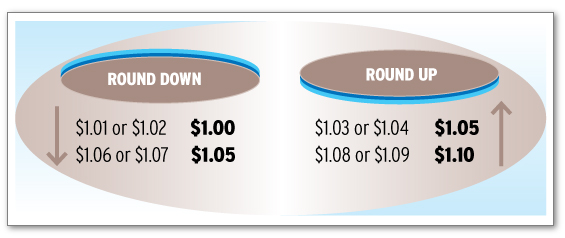
Other (sort of) True Canadian Penny News:
Now that Canada has eliminated the one-cent coin, there is still the issue of the United States continuing to use the penny. What to do? What to do? I can recall vividly, traveling and living in the U.S. and I can remember times when some cashier went out of their way to make me feel worthless, a bit of a penny one might say. These were times when I was making a purchase and a lowly Canadian penny was mixed in with coins! The cashier would give me a look of disgust, segregate my Canadian penny, and push it back across the counter as if I had attempted to pull one over on her. Old ladies would clutch their purses and I would be treated like some penniless drifter.
Well now, here we are with some pretty strong currency and no longer using that lowly penny. I suggest we ready our index fingers and, while continuing to be polite because we should be better than to make them feel ashamed about their little Lincoln-headed (I think the other side is a radiator), but push it back across the counter all the same. Pay-back’s a bitch, eh?
Goodbye one-cent coin. You will be remembered like the one, two and one thousand dollar notes and you will be sort of missed.

On January 14th Canadian sweetheart Rachel Wilson was by Valhalla and signed her Canadian Culture Thing MapleLeafForever stamp (CCT0106)! She was accompanied by her bombshell friend Bomb Girls’ Ali Liebert (upcoming MapleLeafForever stamp inductee).
Ottawa-born Rachel seems to have been in at least one episode of every show produced between 1994 and the present, as well as having a starring role in an impressive 7 series’. She has also been in such major films like Mystery Alaska, the Glass House and Saw 3D.
But at the core, Rachel might hold a everlasting soft-spot in the hearts of the many fans of Breaker High, the cutting-edge drama of life on a high-school cruise ship…you heard me. Rachel co-starred with Ryan Gosling (upcoming MapleLeafForever stamp inductee) as socially-awkward teenagers trying to make their way in a complicated nineties-high-school-cruise-ship world. Laugh all you want at the premise but remember that Joss Whedon’s Firefly barely aired 11 of it’s 14 episodes before being flatly cancelled while Breaker High boasts a whopping 44 episodes. Disney even set sail on this premise again more than ten years later and managed to produce 4 seasons of another ship-school in the Suite Life on Deck. All of us 40-somethings still remember Square Pegs and it only aired 20 grody-to-the-max episodes.
One on my personal favourite roles was a short film Rachel did in 2009, 75 El Camino. 75 El Camino tells the story of a couple trying to make their way in a complicated lost-my-job-lost-my-house-got-a-case-of-the-cancer story of life, death and El Caminos. Rachel plays the ray of sunshine in her parents struggle while the audience wrestles with the philosophical question: Is it a car? Is it a truck?
75 El Camino – Short Film – Directed by Sami Khan from Kevin C. W. Wong on Vimeo.
Rachel has since starred on racey comedies like Show Me Yours with fellow MapleLeafForever stamp inductee Alberta Watson as well as the religious docu-drama My Pal Satan, historical bio-series the Kennedys and the animated-character Heather on Total Drama Island.
Rachel Wilson has spent the past four years co-starring as fiery Dr. Nikki Renholds on the CBC’s acclaimed Republic of Doyle series.